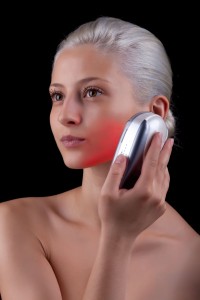 Red light therapy– the use of diffused light in the wavelength range of 620 to 750 to cause changes in a living organism’s tissue- has been researched for many different uses. The research has steadily increased over the past few decades and now we have more information on which conditions red light therapy is good for (and which it is not).
Red light therapy– the use of diffused light in the wavelength range of 620 to 750 to cause changes in a living organism’s tissue- has been researched for many different uses. The research has steadily increased over the past few decades and now we have more information on which conditions red light therapy is good for (and which it is not).
Often, you will see the term “light therapy” referring to the light boxes made to treat Seasonal Affective Disorder (SAD). SAD lights have gained popularity in mainstream medicine because doctors and scientists agree that they are effective. They are ultra bright lights that mimic sunlight, which is another type of light known to help people suffering from SAD. This helps a person with SAD regulate his or her circadian rhythm (known to be part of what causes SAD). What’s great about SAD lights is that not only do they help people who have SAD, they expose people to the idea of light therapy.
However, there are many, many more uses for light therapy that have been researched. (Note: This does not mean light therapy was determined to be effective in all cases on this list.) Some of these potential uses for red light therapy or other light therapy include:
- Acne
- Pain from injury, arthritis, fibromyalgia or other causes
- Healing injuries
- Osteoarthritis
- Dementia, including Alzheimer’s
- Eye injury and degeneration, especially of the retina
- Psoriasis
- Jaundice
- Diseases linked to mitochondrial dysfunction, such as Alzheimer’s and Parkinson’s
- Cancer
- Wrinkles and aging of the skin
- Back pain
- Joint pain
- Tendinitis
- Heel spurs, bunions and other painful foot conditions
- Hair growth
- Diabetic neuropathy
- Restless Legs Syndrome
- Minimizing nerve damage from injury
- Burns
- Pinched nerves
- Eye floaters
- Bruises
- Rosacea
- Eczema and dermatitis
What Uses of Red Light Therapy are FDA Approved?
The FDA has approved certain light therapy devices to be marketed for specific conditions. These conditions include:
- Diabetic neuropathy (880 nm infrared light therapy)
- Ulcers of the mouth in those taking chemotherapy (660 nm red light therapy)
- Wrinkles (infrared light therapy)
- Pimples/acne (infrared, blue and blue/red light therapy combinations, respectively)
- Tendonitis
- Joint pain
- Fibromyalgia